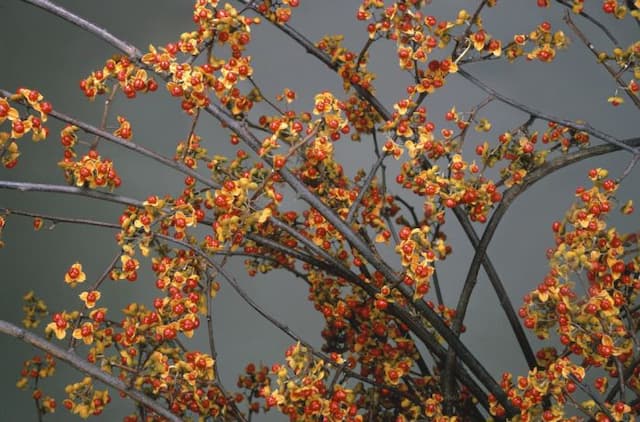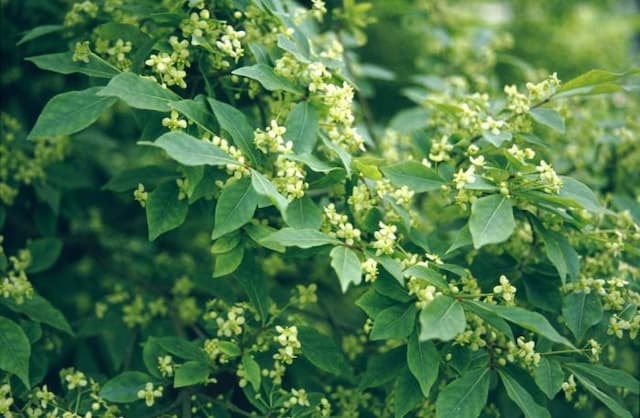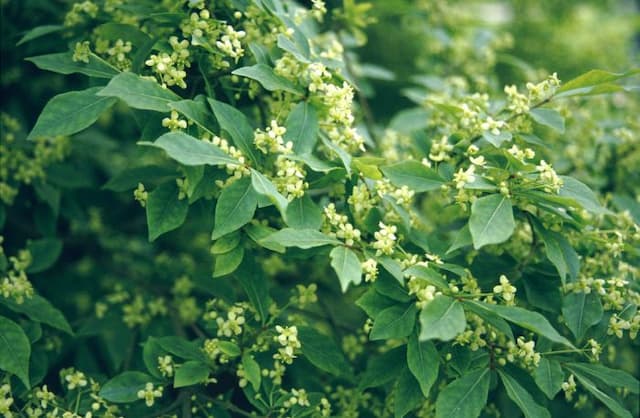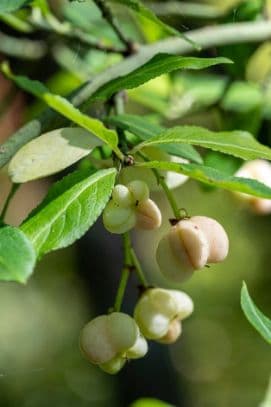Spindle Tree Euonymus phellomanus

ABOUT
Euonymus phellomanus, commonly known as the spindle tree, is a plant that is admired for its distinctive appearance. This ornamental shrub or small tree is recognized for its attractive foliage, which changes with the seasons. The leaves are oval to elliptical in shape and come out in a deep green, bringing a lushness to the garden space. As the cooler months approach, the leaves transform into a bright to deep reddish or purplish hue, providing an eye-catching autumn display. One of the most striking features of the spindle tree is its fruit. In late summer to fall, the plant bears small, inconspicuous flowers that give way to a unique fruiting body. The fruit has a vibrant, almost jewel-like appearance, with a pink to reddish capsule that splits open to reveal seeds encased in a bright orange, fleshy aril. The contrast between the pink capsules and orange seeds is particularly dramatic and adds ornamental value to the plant. The bark and twigs of the spindle tree have a subtle charm. The bark is smooth and light gray, which stands out particularly in the winter months when the leaves have fallen. The twigs may be green to brown, often with a slightly square shape, giving the branches an interesting texture and form. The spindle tree is versatile in landscape use, often incorporated into hedges or used as a standalone specimen for its year-round interest. The combination of its colorful foliage, attractive fruit, and pleasing bark make it a popular choice for gardens seeking visual appeal through various seasons.
About this plant
 Names
NamesSynonyms
Spindle Tree, Cork Tree
Common names
Euonymus phellomanus.
 Toxicity
ToxicityTo humans
The spindle tree contains toxic compounds that can cause adverse effects if ingested. Consumption of any part of the spindle tree can lead to symptoms including nausea, vomiting, diarrhea, weakness, chills, and in severe cases, changes in heart rate and respiratory distress. These symptoms are due to the presence of compounds such as alkaloids and cardiac glycosides which are poisonous.
To pets
The spindle tree is also toxic to pets and can lead to similar symptoms as in humans if ingested. These include vomiting, diarrhea, weakness, and potentially more severe cardiac effects due to the presence of toxic compounds like alkaloids and cardiac glycosides. Pet owners should prevent their animals from ingesting any part of the plant to avoid these health risks.
 Characteristics
CharacteristicsLife cycle
Perennials
Foliage type
Deciduous
Color of leaves
Green
Height
6-10 feet (1.8-3 meters)
Spread
6-10 feet (1.8-3 meters)
Plant type
Shrub
Hardiness zones
5
Native area
China
Benefits
 General Benefits
General Benefits- Landscape Aesthetics: Spindle tree adds ornamental value to landscapes with its vibrant foliage and interesting fruit capsules.
- Wildlife Attraction: The berries of the tree attract birds, providing food for wildlife.
- Low Maintenance: Spindle tree is known to be quite hardy and doesn't require extensive care to thrive.
- Drought Tolerance: Once established, it can tolerate periods of dry conditions, making it suitable for xeriscaping.
- Seasonal Interest: It offers a variety of colors and textures throughout different seasons, enhancing the visual interest of gardens year-round.
- Soil Adaptability: Spindle tree can adapt to a wide range of soil types, from acidic to alkaline.
- Natural Hedge or Screen: Can be used to create natural barriers or privacy screens in garden settings.
 Medical Properties
Medical PropertiesThis plant is not used for medical purposes.
 Air-purifying Qualities
Air-purifying QualitiesThis plant is not specifically known for air purifying qualities.
 Other Uses
Other Uses- Spindle Tree wood is dense and fine-grained, making it suitable for crafting detailed objects like spindles, hence its name.
- The berries of the Spindle Tree can be used to make a yellow dye when combined with alum, despite their toxicity if ingested.
- Its branches have been traditionally used for making skewers and toothpicks due to their hardness and durability.
- Spindle Tree wood can be used to create high-quality charcoal for drawing and artistic purposes.
- Woodworkers value Spindle Tree for making musical instruments such as recorders and other woodwind instruments because of its resonant qualities.
- The hard wood was once used to manufacture textile printing blocks used in traditional fabric patterning processes.
- In marquetry, the light color of Spindle Tree wood can be used to create intricate designs and contrasts with darker woods.
- The compelling fall color and distinctive fruits of Spindle Tree make it a decorative element in dried floral arrangements.
- Euonymus phellomanus branches might be used as natural fencing material in garden design due to their robustness.
- The well-structured shape of the Spindle Tree makes it a candidate for training into a bonsai for enthusiasts of the miniature art form.
Interesting Facts
 Feng Shui
Feng ShuiThe Spindle Tree is not used in Feng Shui practice.
 Zodiac Sign Compitability
Zodiac Sign CompitabilityThe Spindle Tree is not used in astrology practice.
 Plant Symbolism
Plant Symbolism- Fortitude: Often found in harsh environments, spindle trees like Euonymus phellomanus are seen as symbols of endurance and the ability to withstand difficult conditions.
- Adaptability: This plant's capacity to thrive in varied climates signifies adaptability and the ability to prosper in diverse situations.
- Protection: In some cultures, spindle wood has been used to make charms or talismans, believed to protect against harm and negative energies.
- Witchcraft: Due to its use in folklore and various traditional practices, it is sometimes associated with mysticism and the supernatural.
 Water
WaterThe Spindle Tree needs to be watered moderately, aiming to keep the soil consistently moist but not waterlogged. In general, water your Spindle Tree once a week with approximately 1 gallon of water, but this may need to be increased to twice a week during hot, dry spells. Reduce watering in the winter to every other week or when the soil is dry to the touch. Be cautious not to overwater, as this can lead to root rot.
 Light
LightThe Spindle Tree prefers partial shade to full sun. It should be planted in a location where it can receive at least four to six hours of sunlight daily. While it can tolerate full sun, too much direct sunlight might lead to leaf scorch, especially in particularly hot climates.
 Temperature
TemperatureThe Spindle Tree thrives in a temperature range of 50 to 75 degrees Fahrenheit. It can tolerate a minimum temperature down to around 20 degrees Fahrenheit but prolonged exposure to sub-freezing temperatures can be harmful. The ideal conditions are temperate climates where extreme heat and cold are both avoided.
 Pruning
PruningThe Spindle Tree should be pruned to maintain its shape and remove any dead or diseased wood. The best time for pruning is in late winter or early spring before new growth begins. Light pruning can be done yearly, but more severe pruning should be done every few years to rejuvenate older plants.
 Cleaning
CleaningAs needed
 Soil
SoilSpindle Tree prefers a well-drained, loamy soil with a pH range of 6.0 to 7.5. A mix containing equal parts garden soil, peat or compost, and perlite or sand is ideal to ensure proper drainage and aeration. Amend the soil with organic matter to enhance nutrient availability.
 Repotting
RepottingSpindle Trees do not need to be repotted often; every 3-4 years is sufficient. Check if the roots are circling or if the plant is waterlogged, as these are signs it's time to repot into a slightly larger container with fresh soil mix.
 Humidity & Misting
Humidity & MistingSpindle Trees can adapt to a wide range of humidity levels but prefer average household humidity. If the air is too dry, especially in winter, occasional misting can help to raise humidity.
 Suitable locations
Suitable locationsIndoor
Place Spindle Tree in well-lit location, away from drafts, and water regularly.
Outdoor
Plant in sun to partial shade and shelter from extreme weather.
Hardiness zone
4-9 USDA
 Life cycle
Life cycleEuonymus phellomanus, commonly known as spindle tree, starts its life cycle when seeds germinate in spring after a period of cold stratification. The seedling stage is characterized by the sprouting of embryonic leaves and the establishment of a root system. As it enters the juvenile stage, the spindle tree develops its distinctive oval-shaped, green leaves and begins to form a woody stem. In maturity, the spindle tree produces small, inconspicuous flowers, which are typically greenish-white and bloom in late spring to early summer. Following pollination, typically by insects, it develops its characteristic pink to red fruits, which open to reveal bright orange seeds in the fall. The adult plant will drop these seeds to complete its reproductive cycle, and it may live for several years, continuing to grow and produce flowers and fruits annually.
 Propogation
PropogationPropogation time
Spring to early summer
Euonymus phellomanus, also known as spindle tree, is most commonly propagated by seed. This process begins in the fall when the seeds are ripe. The collected seeds should first be cleaned and then stratified for about 18-20 weeks in moist sand at a temperature of 41 degrees Fahrenheit (5 degrees Celsius) to break dormancy. Following stratification, seeds are sown in a well-draining seed starting mix and lightly covered with soil. It's important to keep the soil lightly moist and maintain a temperature of about 68-72 degrees Fahrenheit (20-22 degrees Celsius) for germination. Once the seedlings are large enough to handle, they can be transplanted into individual pots and eventually moved outdoors when they are robust enough to survive the elements.




![Spindle [Blondy]](/_next/image?url=https%3A%2F%2Fplants-admin.emdemapps.com%2Fimages%2Fplants%2F%2Fimages%2F604b642f54add.png&w=640&q=75)


